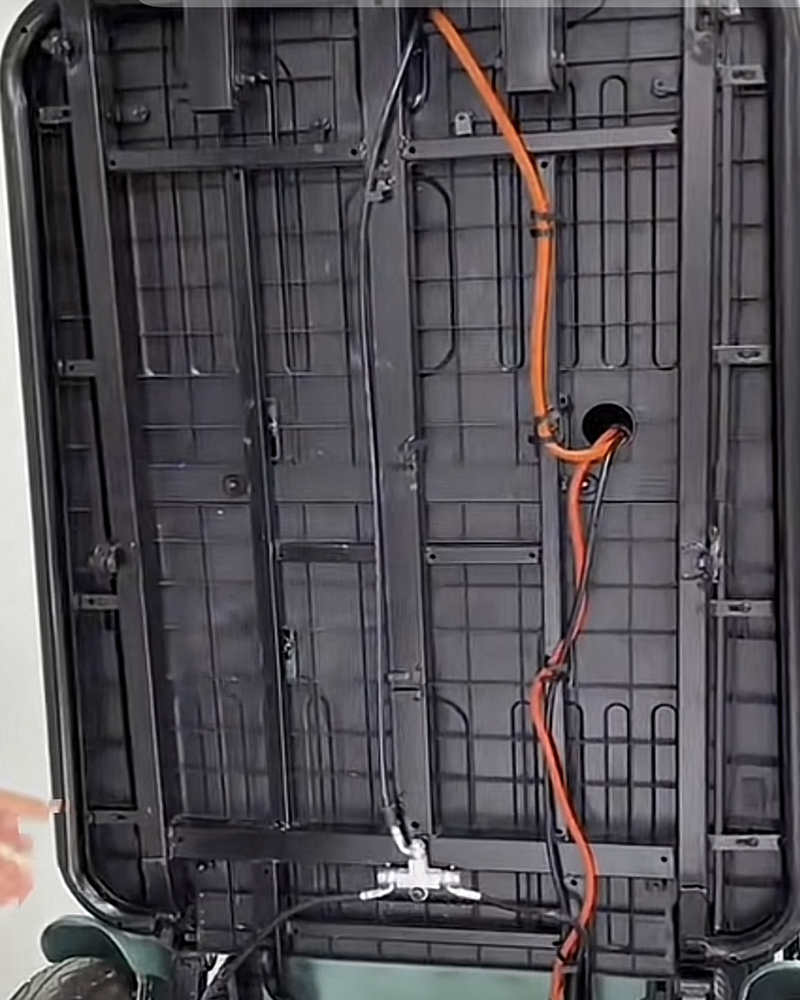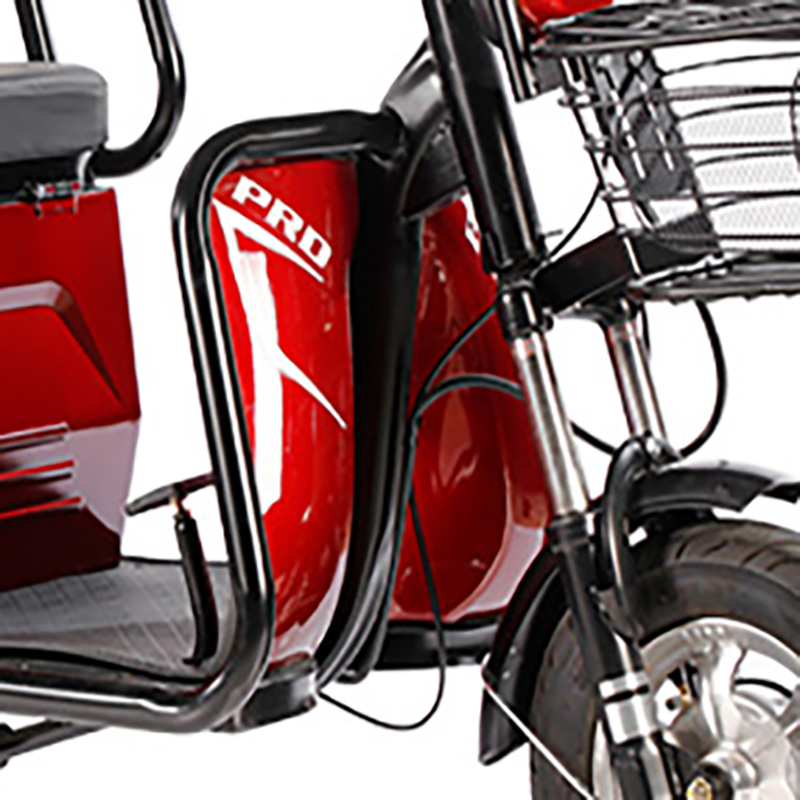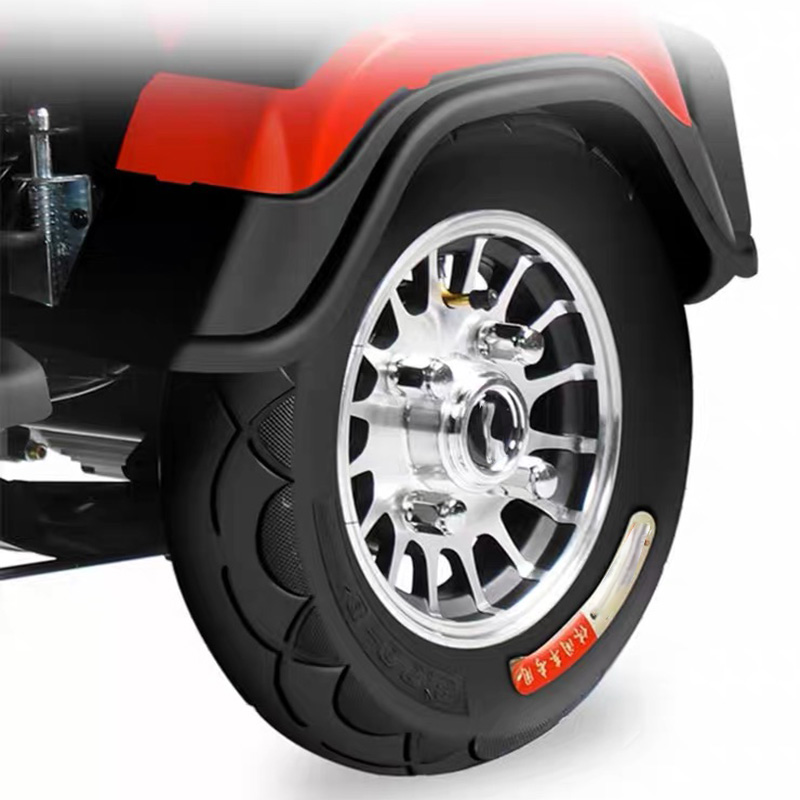
Ntụrụndụ Onye nrụpụta E-Tricycle
AGL-TRIKE na-anabata ndị na-azụ ahịa buru ibu n'ụwa ebe ịdịmma na-ezute oke n'ime ụgbọ ala ntụrụndụ eletrik. Anyị, dị ka ndị na-emepụta ihe, na-emesi obi ike na ọ bụghị naanị na ọ na-enye ya mana ọ bụkwa mpaghara ebe enwere ike ịhazi igwe tricycle ọ bụla maka mkpa ahịa gị. Jiri igwe ọgbara ọhụrụ anyị arụpụtara nkenke, nke dị mma na nke kwụsiri ike, ka anyị tụba n'ọdịnihu nke uto na ịga nke ọma.
Isiokwu ọdịnaya maka ibe a
Iji jide n'aka na ị nwere ike ịchọta ozi gbasara ya akụkụ niile nke omenala ntụrụndụ tricycle eletrik ị chọrọ ngwa ngwa, anyị akwadola akwụkwọ ndekọ aha ọdịnaya nke ga-awụlikwa elu na ebe kwekọrọ mgbe ị pịrị ya.
Ịchọgharị Ụdị dị iche iche na Ntụrụndụ Eletrik Trikes
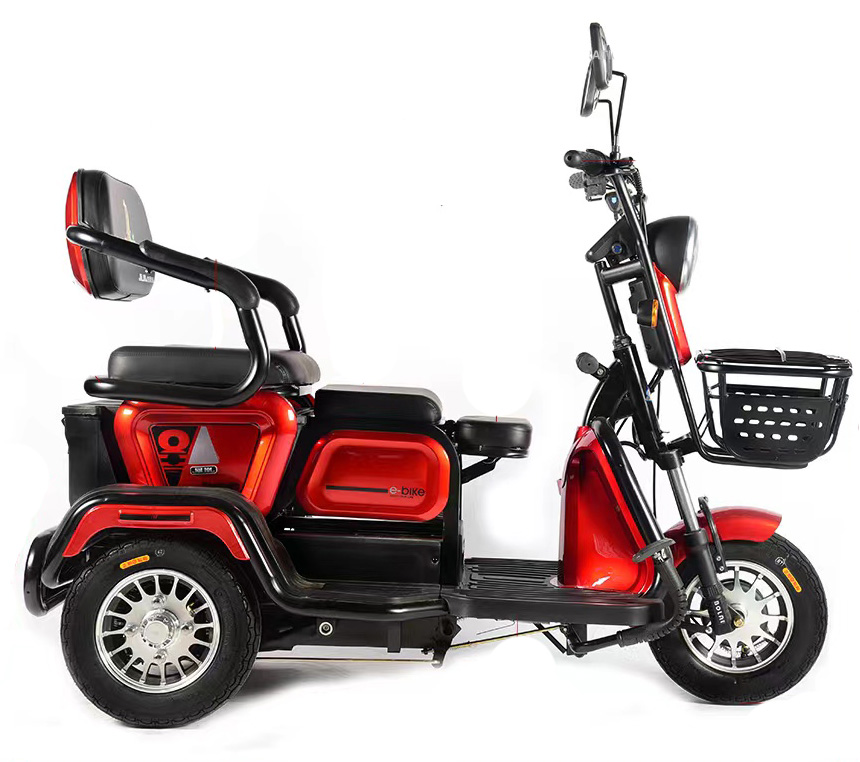
Atụmatụ:
Bugharịa oche ahụ azụ na azụ wee tụgharịa oche ihu ka iburu mmadụ abụọ pụọ. Oche ụmụaka zoro ezo, chebe nchekwa nwa nke ọma, zere ịdị arọ, nwere ike iburu mmadụ atọ.

Ọkpụkpụ:
E-Trike pere mpe, ahịrị okpukpu abụọ;E-Trike dị n'ahịrị okpukpu abụọ;E-Trike buru ibu nke okpukpu abụọ nke nwere ike dabara n'ụdị ojiji dị iche iche yana ịhazi ya maka mkpa gị.
Sistemụ ịnya ụgbọ ala: Na-eme ike Tricycle nke ntụrụndụ eletrik
N'ime ụwa nke igwe kwụ otu ebe ntụrụndụ, moto na-enweghị brush na-achị nke ọma, ụdị nke ọ bụla na-enye uru pụrụ iche ahaziri dabere na ihe ndị ọrụ chọrọ na ohere mmefu ego dị iche iche.

Nkọwa moto
Ụgbọ ala BLDC:
- Nhọrọ akụ na ụba: Ndị ọzọ na-emefu ego, moto ndị a na-eje ozi dị ka ebe a na-enweta n'ime ahịa ọgbara ọhụrụ atọ.
- Ọkwa mkpọtụ: N'ụzọ doro anya, ha na-emepụta hum ma ọ bụ ikuku a na-ahụ anya n'oge a na-arụ ọrụ, nke nwere ike ịhụ na gburugburu ebe dị jụụ.
PMSM Motors (moto sine wave):
- Arụmọrụ adịchaghị: Mgbe ha na-ebu mkpado ọnụahịa dị elu, ha na-ahụ na ịnya ụgbọ elu nwere ike, dị nro na nke dị jụụ.
- Ọdịnaya emelitere na Torque: Ọbụghị naanị ijide n'aka na ịnya ụgbọ elu siri ike yana kwụsie ike, mana igwe PMSM na-ekwekwa nkwa ogologo ndụ yana ike siri ike, na-akwado ike n'akụkụ dị iche iche na ọnọdụ ojiji.
Na AGL-TRIKE, anyị na-eduzi gị site na nhọrọ moto ndị a, na-agba mbọ hụ na ị nweta ụdị nke na-agbaso mkpa gị, ojiji na mmefu ego gị, na-emepụta ahụmịhe ọgbara ọhụrụ nke bụ nke gị pụrụ iche.
igodo Parameters nke moto
Ịghọta Ike moto: Ụdị na ike nke moto ị na-ahọrọ ga-akpụzi arụmọrụ nke tricycle na ịrụ ọrụ izugbe.
| Enyere ike (W) | Ọnọdụ ojiji akwadoro |
|---|---|
| 500W ruo 650W |
Zuru okè maka Single na Small Dual Row E-Trikes: Na-eme nke ọma na otu ahịrị E-Trikes na kọmpat ụdị ahịrị abụọ, na-enye ngwakọta nke ike akụ na ụba na ịnya igwe dị larịị. Nchekwa na nkwụsi ike maka ndị skuuta okenye: A họọrọ nke ọma maka ndị skuuta ntụrụndụ ndị agadi, moto ndị a na-eme ka ịnya ụgbọ ala dị mma ma kwụsie ike, na-enweghị oke ọsọ. Ịnyagharị enweghị mbọ: jiri moto anyị 500-650W merie obodo mepere emepe na mkpọda dị nro. |
| 800W |
Ike emelitere na ụdị dị iche iche: Na-enye ahụmịhe ịnya ụgbọ ala siri ike yana ikike ijikwa ibu ọzọ na ala dị iche iche. Excellent Uphill Performance: Capably handles steeper inclines up to 30 degrees, making it an optimal choice for double-row leisure trikes, ensuring smooth and powerful ascents even on challenging slopes." |
| 1000W na n'elu | Ike kacha mma na ikike: Ọ dị mma maka ọnọdụ ọnọdụ na-achọ ike kachasị, dị ka ala na-ama aka ma ọ bụ ibu ibu dị arọ. Kachasị mma maka oge ntụrụndụ nwere ahịrị abụọ, na-anabata ọ bụghị naanị onye ọkwọ ụgbọ ala kamakwa ndị okenye abụọ ọzọ. Ọ bụ ezie na ha na-enye ike pụrụiche, a na-ejikarị moto ndị a eme ihe n'ụdị ntụrụndụ, n'ịtụle ike ha nwere ike karịa ihe ndị chọrọ oge ntụrụndụ. |
Understanding Torque (Nm): It's the measure of "force" driving a vehicle's initiation and its capacity to ascend inclines.
Mgbe ị na-ahọrọ igwe eletriki igwe eletrik, torque - ike ịnya ụgbọ ala na-ebuli gị gaa n'ihu na elu - bụ ihe dị oke mkpa. Nke a bụ ihe ị kwesịrị ịma:
Arụmọrụ n'echiche: Ọ bụ ezie na ọ bụ eziokwu na moto ndị nwere ikike dị elu na-ebukarị ike, nke dị mkpa maka ọrụ dị arọ dị ka ịkwọ ụgbọ mmiri, igwe atọ nwere ntụrụndụ na-arụ ọrụ n'ime ọnọdụ dị iche. Emebere ha nke ọma maka ịdị mma, iji ya eme ihe kwa ụbọchị kama ibuli elu ma ọ bụ ịgagharị n'ala ndị siri ike.
Ịrụ ọrụ karịrị ngafe: Ọtụtụ igwe kwụ otu ebe ntụrụndụ nwere moto 500W nwere ike rịgoro steepụ nke ọma na nke ọma na-enweghị nsogbu. Maka onye ọrụ a na-ahụkarị, na-agbagharị n'ogige ntụrụndụ, agbataobi, ma ọ bụ n'okporo ámá obodo, ọkwa a abụghị naanị nke zuru oke kamakwa ọ kachasị mma, na-eme ka ngwakọta nke arụmọrụ, nchekwa ike, na ogologo ndụ batrị.
- Haziri maka ọrụ: Ịhọrọ moto ziri ezi bụ ihe dị mkpa maka ahụmịhe ịnya ụgbọ ala achọrọ. Na-ebu ndị njem okenye ugboro ugboro, tụlee moto siri ike maka ịrụ ọrụ na-agbanwe agbanwe. Agbanyeghị, maka ịnya oge ntụrụndụ nwere ọnọdụ okporo ụzọ dị mma, ọkachasị ndị agadi, obere moto zuru oke. Ọ na-enye ngwakọta zuru oke nke ọsọ, nkasi obi, na arụmọrụ na-enweghị ibu ma ọ bụ ụgwọ na-enweghị isi
Ọsọ (RPM): A na-atụle oke ọsọ nke igwe kwụ otu ebe site na ọsọ ntụgharị ya.
Ọ bụ ezie na mmụba RPM na-egosipụtakarị ọsọ kachasị ọsọ ọsọ, ihe ndị ọzọ dị ka igwe mgbasa ozi, ịdị arọ tricycle na ibu nwere ike imetụta nsonaazụ n'ezie.
Họrọ AGL, anyị ga-eduzi gị n'ịhọrọ ike na ụdị moto dị mgbagwoju anya, na-ahụ na ụgbọ ala gị na-arụ ọrụ kachasị mma na arụmọrụ.

Nkọwa njikwa
Onye njikwa na-arụ ọrụ dị ka obi nke ụgbọ okporo ígwè, na-eduzi ugbu a kwesịrị ekwesị na moto kwekọrọ na ntụzịaka trotul. Ọrụ ya dị oke mkpa n'ịtọpụta ma osooso na oke ọsọ.
Usoro nchekwa: Ihe ndị a na-agụnye ihe nchebe dị ka ihe na-emebiga ihe ókè, nkwụsị voltaji dị ala, na nchekwa ọkụ
igodo Parameters nke njikwa
Mgbe ị na-ahọrọ onye njikwa, ọ dịkwa mkpa iji hụ na ndakọrịta na moto. Ọ bụrụ na moto bụ sine wave moto, mgbe ahụ, a ga-ahọrọ onye na-ahụ maka sine wave kwekọrọ.
Ihe nrụpụta kacha ugbu a (A): Na-anọchi anya ike kachasị ike nke onye njikwa na-enye moto.
Nkọwapụta voltaji (V): Kwesịrị ịkwado na voltaji batrị.
Ụdị voltaji: Dị na 36V, 48V, 60V, 72V na ndị ọzọ, na 60V na-amasịkarị.
Nkewa site na Transistor Power: Ndị njikwa dị na nhazi nwere 9, 12, 15, 17, 18, 24, 36 transistors, na ndị ọzọ. Ọnụọgụ nke transistors ike na-egosi ike moto dabara adaba:
- 9 transistors: Kwesịrị ekwesị maka ndị na-agba ịnyịnya bụ ndị na-ebute ụzọ dị jụụ na ịrụ ọrụ nke ọma.
- 12 & 15 transistors: Kwesịrị ekwesị maka ndị na-achọ ntakịrị ọsọ na arụmọrụ. Ọ bụ ezie na ha na-ebuga njem siri ike karị, ha na-abịa na ọnụ ahịa dịtụ elu ma na-eri ike karị.
Ịhọrọ onye njikwa na nkọwa kwesịrị ekwesị, anyị nwere ike hụ na moto na-enweta ihe ziri ezi ugbu a, na-eme ka osooso na ọsọ ọsọ nke tricycle eletriki ntụrụndụ.

Nhọrọ nke Rear Axle maka E-Tricycles ntụrụndụ
Axle n'azụ bụ ihe dị mkpa maka ịrụ ọrụ nke igwe kwụ otu ebe ntụrụndụ. Ọ na-enye nkwụsi ike na nguzozi, na-eme ka ịnya ụgbọ ala dị jụụ na nke dị larịị n'ofe ala dị iche iche. Ịhọrọ axle azụ dị mma na-akwalite ntụkwasị obi nke igwe kwụ otu ebe ntụrụndụ gị maka njem dị ntụsara ahụ na nke echefuru echefu. Nhọrọ gị na-ahụ na ịnya ụgbọ ala ọ bụla bụ ngwakọta nke arụmọrụ na nchekwa.
Njikọ azụ Axle (ya na Iche)
Uru:
- Kọmpat: Nhazi dị mfe yana nrụnye dị mfe.
- Ntụkwasị obi: Akụkụ njikọ dị ole na ole pụtara ikike maka ịdịte aka na-abawanye.
- Ntughari: Ọ bụ ezie na igwe kwụ otu ebe ntụrụndụ anaghị achọ oke ibu ibu, axle agbakwunyere na-enye mgbanwe maka ibu dị arọ mgbe ụfọdụ ma ọ bụ ndị njem ọzọ.
Ihe ọghọm:
- Nlekọta: Ọ bụrụ na ihe ndị dị ka ihe dị iche chọrọ nlebara anya, ngalaba axle dum nwere ike ịchọ nrụzi ma ọ bụ ngbanwe.
- Nha na mkpochapụ: Axle agbakwunyere dị ukwuu karịa axle azụ ekewapụrụ. Nyere chassis dị ala nke ọtụtụ cycles ntụrụndụ, enwere oke ohere, na-eme ka axle azụ agbakwunyere bụrụ nhọrọ na-adịkarị obere.
- Ọnụ: Ọ na-adị ọnụ ahịa karịa ogbo ya nke kewara.
Ọ bụ ezie na enwere ike ịhụ axle azụ agbakwunyere n'ime ọgba tum tum oge ntụrụndụ, ngwa ya dị ụkọ n'ihi nhazi tricycle na ebumnuche ojiji mbụ.
Nkeji n'azụ Axle (ya na ihe dị iche)
Uru:
Nkwado: Ezubere maka ịdị mfe nke mmezi. Ọdịdị modular na-enye ohere ka a dochie anya akụkụ ụfọdụ mebiri emebi, na-egbochi mkpa ịmegharị usoro ahụ dum.
Dị ọnụ ahịa: N'ozuzu obere ọnụ ala, na-enye nguzozi n'etiti ịdịmma na ọnụ ahịa, karịsịa maka ndị ọrụ ezinụlọ.
Ibu ibu zuru oke: Ọ bụ ezie na ọ nwere ike inwe ikike dị ala karịa axles agbakwunyere, maka ndị na-agba ọsọ ntụrụndụ na ndị njem oge ụfọdụ (dị ka ụmụaka ma ọ bụ okenye ọzọ), ọ na-egbo mkpa nke ụbọchị na nke ọma.
Ihe ọghọm:
- Nlekọta oge niile: N'ihi nhazi akụkụ ya dị iche iche, nlele na nrụzi oge ọ bụla enwere ike ịchọọ ugboro ugboro iji hụ na arụmọrụ kacha mma.
Axle azụ nke kewara ekewa na-enye ngwakọta ziri ezi nke ịdị mma na arụmọrụ, na-eme ka ọ bụrụ nhọrọ maka ọtụtụ cycles ntụrụndụ emebere maka ndị na-agba okenye na njem ezinụlọ.
Na AGL-Trike, anyị na-anya onwe anyị ọnụ maka mgbanwe na mgbanwe anyị. Na-eri nri kpọmkwem maka ndị na-ere ahịa mba ụwa, anyị na-ahazi onyinye anyị dabere na mmefu ego gị yana ihe pụrụ iche chọrọ. Site na nka siri ike anyị dị ka onye na-emepụta igwe eletriki igwe eletrik, anyị agba mbọ wepụta azịza dabara nke ọma na mkpa gị.

Isi Parameters nke azụ Axle:
The gearbox, centrally dị n'ime n'azụ axle, ọ bụghị nanị na-ejikọta abụọ wiil site na ọkara-osisi ma na-etolite a dị oké mkpa njikọ na moto.Ije ozi dị ka oké mkpa mbanye na nnyefe ngwaọrụ.
N'ime igbe gear bụ ihe dị mkpa - ihe dị iche. Site n'ime gia nke dị iche iche, ike nke moto na-ebugharị na-ebufe ya na ọkara-axles abụọ, na-ekwe ka wiil ọ bụla na-agbagharị na ọsọ ọsọ dị iche iche. Nhazi a pụrụ iche na-eme ka o doo anya na, mgbe trike ntụrụndụ na-atụgharị, wiil ndị ahụ nwere ike ịga ebe dị iche iche, na-ejigide nkwụsi ike na ịdị nro.
The gia ruru n'ime dị iche iche na-ekpebi otú ike na-ebufe si moto na wiil. Oke nnyefe a na-emetụta mkpali mbụ nke trike, oke ọsọ na ike ike. N'ihi ikike mbufe mmiri dị iche iche na ike mgbago elu ya na ibu ibu, a na-eji ya eme ihe na ntụrụndụ. Ọ bụghị naanị isi ihe dị n'azụ axle kamakwa ọ na-arụkwa ọrụ dị mkpa n'ịkwalite arụmọrụ zuru oke nke trike.
Oke akụrụngwa:
Dị ka e gosiri na ihe atụ a, ndị iche nwere njikọ dị n'etiti ọnụ ọgụgụ eze na ngwa ụgbọala (na-ejikọta ya na moto) na dgia riven (nke a na-ejikọkarị na wiil).
Ọmụmaatụ:
- Site na nha 3: 1 gear, ngwa mbanye (site na moto) na-atụgharị ugboro 3 iji mee ka akụrụngwa ebugharị (na wiil) tụgharịa otu ugboro, na-enye ọsọ ọsọ dị elu na-efu ikike ibu ibu.
- N'ụzọ dị iche, nha 5: 1 na-eme ka akụrụngwa mbanye na-agbagharị ugboro 5 maka otu ọ bụla nke ngwa a na-ebugharị, na-ebuli ike na ịdọrọ ike, n'agbanyeghị na obere ọsọ.
Cheedị echiche banyere igwe eletrik eletrik abụọ, nke ọ bụla nwere otu njirimara moto mana oke dị iche iche. Otu egwuregwu nwere nha 31:10 na nke ọzọ, 35:14. Tricycle nwere nha 35:14 nwere ike karịa opekata mpe 10 km / h, mana ọ na-emebi ikike mbugharị ya.
Mgbe a na-enyocha ihe mgbakwasị ụkwụ eletrik na-agba ọsọ na ike site na oke dị iche iche ya: oke mbelata na-egosi ịdabere n'ọsọ, ebe agbakwunyere na-atụ aka na ike na ike.

N'ime nguzobe anyị, a na-eji nkenke na nlebara anya rụọ igbe gear ọ bụla, na-achọ ịnye ọrụ kacha mma n'ofe igwe eletriki eletrik anyị. Nkwenye anyị na-adịghị agbanwe agbanwe na-eme ka nnyefe ike dị irè na nke na-agbanwe agbanwe site na moto gaa na wiil, na-ekwe nkwa ma ọrụ pụrụ iche yana ogologo ogologo oge maka trike gị!
Batrị dị mkpa maka Tricycles ntụrụndụ
Mgbe ị na-ahọrọ igwe kwụ otu ebe eletriki ntụrụndụ, ntachi obi batrị bụ ihe kacha mkpa. Gbaa mbọ hụ na batrị ọ bụghị naanị na-enye ogologo ogologo mana na-ekwekwa nkwa ogologo ndụ maka ọtụtụ ihe egwu dị n'ihu
Lithium-ion vs. Lead-Acid: Ntụnyere
| Parameter/Voltaji | Batrị lithium-ion | Batrị Acid Lead |
|---|---|---|
| Ọnụ ahịa ịzụta | Ọnụ ego ntinye ego mbụ dị elu | N'ozuzu karịa ọnụ ala mana ọ nwere ike ịchọ ka edochi anya karịa |
| Nchekwa na kwụsie ike | Nwere ike na-agbanwe karịa n'okpuru ọnọdụ dị ka ịchaji karịa mana ọ na-abịa na sistemụ njikwa batrị dị elu (BMS) maka nchekwa | Ka kwụsie ike |
| Ibu | Ọkụ dị ọkụ ma dị ike karịa, na-eme ka ha dị mma maka ngwa ngwa | E jiri ya tụnyere batrị lithium nke otu ikike, ọ nwere nnukwu olu ma dị arọ karị |
| Ogologo ndụ | N'ozuzu, na-enye ogologo ndụ ogologo oge yana ọnụ ọgụgụ dị elu nke usoro ịgbasa ụgwọ | Ogologo ndụ dị mkpụmkpụ ma na-eweda ngwa ngwa mgbe ọnụọgụ okirikiri ụfọdụ gasịrị |
| Ọsọ nchaji | Ike ịchaji ngwa ngwa | Oge nchaji ji nwayọọ nwayọọ |
| Oke na arụmọrụ na ọnọdụ oyi | Na-ejigide arụmọrụ dị mma n'oge oyi, mana oke nwere ike ibelata ntakịrị | Na-enwekarị ike ịdaba arụmọrụ na ihu igwe oyi, na-ebute mbelata oke |
A na-ejikarị batrị lead-acid na batrị lithium eme ihe na ntụrụndụ. Nhọrọ gị nwere ike dabere na mmefu ego gị
Họrọ ikike batrị
| Parameter/Voltaji | 48V | 60V |
|---|---|---|
| Ọnụọgụ batrị | 4 batrị | 5 batrị |
| Ikike nkịtị | 20 ah, 32 ah, 45 ah | 32 ah, 45 ah |
| Na-atụ aro ike | Kwadoro iji ikike nke 32ah na 45ah. Nke a bụ n'ihi na ike nke 20ah na-enye oke oke gburugburu 40KM. Ọ bụrụ na a na-eji ụgbọ ala eme ihe ugboro ugboro, ịchaji oge niile ga-eme ka ịka batrị dịkwuo ngwa ma belata ndụ ya | kwadoro iji 32ah. Ọ bụrụ na ọ dị mkpa ịhọrọ 45ah, ụfọdụ ihe achọrọ maka ụdị ụgbọ ala ga-emezurịrị. Nke a bụ n'ihi na batrị 45ah buru ibu na nha, yana ọtụtụ ihe ntụrụndụ nwere ike ọ gaghị enwe ohere nchekwa batrị zuru oke. |
| Oke njem ụgbọ mmiri | 50-90 kilomita | 50-100 kilomita |
Maka ntụrụndụ, batrị 48V na 60V na-enye ike zuru oke maka ọtụtụ ndị na-agba ọsọ na-enweghị mkpa oke ọsọ. Otú ọ dị, ọ bụrụ na ị nwere ihe ndị chọrọ nhazi nke ọma, egbula oge iru. Na AGL-Trike, anyị kpebisiri ike ịnye azịza kachasị mma ahaziri maka mkpa gị
Usoro igodo ndị ọzọ gbasara batrị
- Nkwenye ikaỤdị ọkwa dị elu na-egosipụtakarị stampụ nke ịdị mma na ntụkwasị obi, na-atachi obi nleba anya nke ọma wee nweta ọnyá ha n'ahịa.
- Ụbọchị mmepụta: Batrị nwere ụbọchị nrụpụta ọhụrụ na-ekwe nkwa ogologo ndụ yana ịrụ ọrụ na-agbanwe agbanwe.
- Usoro nchekwa: Ọ dị mkpa ịhọrọ batrị ejiri usoro nchebe wusie ike megide okwu ndị dị ka ịchaji, nfefe, na mkpirisi ọkụ eletrik.
- Ebe batrị na ịdị arọ: Ihe abụọ a na-ekere òkè dị mkpa n'ịkwado nguzozi ụgbọ ala. Ọ dị mkpa ịhọrọ batrị na-emeju nhazi nke ụgbọ ala maka nkwụsi ike kachasị.
Mgbe a bịara na nhọrọ batrị, ọ dị mkpa ka ị ghara ịchụso voltaji na ikike kachasị elu. Na AGL, anyị bịara ebe a iji duzie gị n'ịchọpụta ntọlite batrị ziri ezi nke ahaziri dabere na ọnọdụ ojiji ụwa n'ezie nke ahịa tricycle eletrik zubere. Site n'ịmekọrịta nguzozi zuru oke nke ike moto na ihe eji eme ihe, anyị agba mbọ na-ebuga arụmọrụ tricycle kacha elu. Karịa nke ahụ, anyị na-ahụ na ntinye ego gị ga-aba uru, na-ebuli oke ọnụ ahịa na-arụ ọrụ.
Ntụrụndụ Electric Trike Sistemụ nkwusioru Nchịkọta
Sistemụ nkwusioru n'ihu
Fork Shock Absorber
Ịhọrọ nkwusioru n'ihu ziri ezi dị oke mkpa maka ịnya ụgbọ ala dị mma, ọkachasị n'elu ala na-ezighi ezi. Nkwụsịtụ dị mma nwere ike ibelata ike ọgwụgwụ nke ukwuu n'oge ịnya ụgbọ ala, na-ahụ na njem ọ bụla bụ ihe ụtọ.
Nhọrọ ihe:
- igwe: Na-adịgide adịgide ma na-adịkarị ọnụ ala.
- Aluminom Alloy: Dị ọkụ ma nwee ike na-enye arụmọrụ dị nro, mana ọ na-adịkarị na ọnụahịa dị elu.
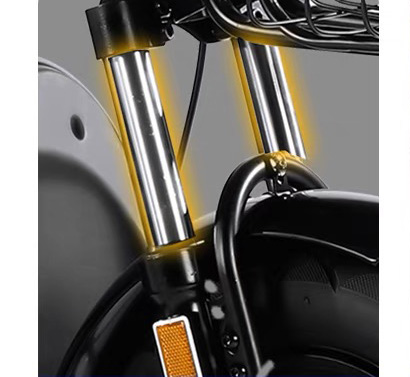
Ezi ndụdụ nke hydraulic damper:
- Arụmọrụ: Na-enye nnabata ujo dị elu. Usoro ya dabere na mmiri mmiri na-eme ka ịnya ụgbọ mmiri na-aga nke ọma ọbụlagodi n'okirikiri ala.
- Ogologo oge: Ejiri ihe ndị dị elu rụọ ya, a na-eme ya ka ọ dịgide ma na-achọkwa nlekọta na-adịchaghị mma.
- Ọnụ ahịa: Na-eche na ọ dị oke ọnụ karịa n'ihi nhazi ọkaibe ya yana ịrụ ọrụ ka mma.
Mock-Hydraulic Damper Fork:
- Arụmọrụ: Na-enye nnabata ujo bụ isi. Ọ bụ ezie na ọ na-eṅomi ọdịdị nke usoro hydraulic, arụmọrụ ya enweghị ike dakọtara na ezigbo ụdị.
- Ogologo oge: Enwere ike ịka nká ngwa ngwa n'ihi nkwekọrịta na imewe na ihe.
- Ọnụ ahịa: Ndị ọzọ na-emefu ego, na-eme ka ọ bụrụ ihe a na-ahụkarị n'ụgbọ okporo ígwè ndị dị ọnụ ala.
Ogologo na dayameta – Ihe dị nro ma dị mkpa:
Ọ bụ ezie na ihe na ụdị nkwusioru nkwusioru n'ihu na-ekpebi n'ụzọ dị ukwuu ịrụ ọrụ ya, mmadụ ekwesịghị ileghara ịdị mkpa nke ogologo ya na dayameta anya anya. Akụkụ ndị a nwere ike imetụta ọ bụghị naanị mma na ọnọdụ nke tricycle kamakwa ọnụahịa ya.
Maka ndị na-ezubere akụkụ ahịa dị oke ọnụ ahịa, ọ dị mkpa ịmata na họrọ maka nhazi ndụdụ n'ihu dị elu n'oge ịzụrụ. Nhọrọ nke ndụdụ n'ihu ọ bụghị nanị na-emetụta nkasi obi ịnya ụgbọ ala kamakwa ọ na-agbakwụnye uru na njirimara ngwaahịa na arụmọrụ.
Sistemụ nkwusioru azụ
Azụ tricycle bụ ebe onye na-agba ma ọ bụ ndị na-agba ịnyịnya na-anọdụ ala. Nkwusioru azụ dị mma na-eme ka a mara na ha na-anọpụ iche site na mmetụta na-emebi emebi nke ala na-ekwekọghị ekwekọ. Ma ọ bụ njem ntụrụndụ na ogige ntụrụndụ ma ọ bụ njem n'okporo ámá nkume nkume, usoro nkwusioru azụ na-eme ka ihe ndị ahụ na-eme ka ndị na-agba ọsọ na-enwe mmetụta dị nta.
Hydraulic na-ekpo ọkụ na Coil Absorber
N'ebe a na-atụrụ ndụ tricycle, nchikota nke Damping Hydraulic na Coil springs guzo dị ka nhọrọ nkwusioru azụ kachasị ewu ewu. Tandem a na-enye ngwakọta pụrụ iche nke nkasi obi na njikwa, na-eme ka ndị na-agba ịnyịnya na-enwe ahụmahụ dị nro, n'agbanyeghị ebe ahụ.
Uru:
- Absorption kwekọọ n'otu: Ọ bụ ezie na eriri igwe na-ahụ maka ịmịnye ujo mbụ, hydraulic damping na-emezigharị usoro ahụ, na-egbochi oscillations ọ bụla gachara.
- Ntughari: Njikọ a nke ọma na-ejikwa ọtụtụ ala dị iche iche, na-eme ka ma obere ezughị okè okporo ụzọ na nnukwu ọnya na-agagharị nke ọma.
- Ogologo ndụ & Ịdị ogologo: Usoro abụọ ahụ na-eme ka ndụ nke tricycle dịkwuo elu site n'ịkesa nrụgide n'etiti ihe abụọ, si otú a na-ebelata ike ọgwụgwụ na nke ọ bụla.
Akụkụ igodo:
- Ọnụọgụ na-akụda mmụọ: Ọ dị mkpa maka ịkọwa nkasi obi ịnya ụgbọ ala. Ọnụego mgbakasị nke ọma na-eme ka o doo anya na igwe kwụ otu ebe ahụ nwere nkwụsi ike n'oge ịnya ụgbọ ala, na-ewepụghị mmetụta dị nro.
- Ọnụego mmiri: Ọ bụ ihe dị mkpa n'ịchọpụta nzaghachi nke tricycle. Ọnụego mmiri ziri ezi na-eme ka o doo anya na igwe kwụ otu ebe ahụ ka kwụ n'ala na-enweghị isi ike.
- Nhọrọ ihe: Iji ihe dị ka ígwè na-adịgide adịgide maka usoro hydraulic na mmiri iyi na-ekwe nkwa ịrụ ọrụ na-agbanwe agbanwe na ogologo ndụ.
- Ngbanwe: Ikike imezigharị ntọala hydraulic damping na coil mmiri nwere ike ịba uru maka ime mgbanwe na mpaghara dị iche iche ma ọ bụ mmasị ndị na-agba.
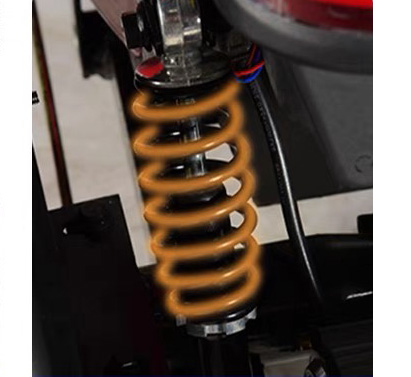
Ịdị mma na ịdị irè nke usoro nkwusioru adabereghị naanị na nkọwapụta nke ndị na-ebu ujo.
Nhazi nhazi nke nkwusioru n'onwe ya na-arụ ọrụ dị mkpa n'ịkwalite nkasi obi ịnya ụgbọ ala. Dịka ọmụmaatụ, ma onyonyo abụọ na eserese atọ gosipụtara sistemu nkwusioru onwe ha, bụ nke na-enye ahụmịhe ịnya ụgbọ elu ka elu ma e jiri ya tụnyere atụmatụ ọdịnala. Ọzọkwa, foto nke atọ, nke nwere ihe ndị na-ama jijiji abụọ ọzọ, na-ekwe nkwa ịnyagharị nke ọma na nke dị nro karị, na-eme ka nkasi obi na ịrụ ọrụ dịkwuo mma.
Na AGL-Trike, gafere onyinye ọkọlọtọ anyị, anyị na-ahazi azịza iji kwekọọ mkpa gị na ihe pụrụ iche nke ahịa mpaghara gị. Site n'ọhụụ gị na nka anyị, anyị na-agba mbọ ịtụgharị echiche gị ka ọ bụrụ eziokwu, na-eme ka nkwekọ zuru oke na ebumnobi na mgbochi gị.
Frame &Ọdịdị nke igwe ntụrụndụ ntụrụndụ eletrik
Ihe Frame Primary – Igwe igwe
- Ọkpụrụkpụ: Ọkpụrụkpụ ígwè ọkpụrụkpụ n'ime ihe ntụrụndụ tricycle na-adịkarị n'etiti kpọmkwem millimeters. Ọ dị mkpa ịtụle ịdị arọ nke etiti ahụ n'ihi na ọ na-emetụta ogologo oge na ịdị arọ.
Mechaa – Agba esitere
- Nchedo na Aesthetics: Agba a na-eme achịcha na-arụ ọrụ dị ka oyi akwa nchebe, na-echebe etiti ígwè ka nchara na iyi. Tụkwasị na nke ahụ, ọ na-enye ọdịdị tricycle na-egbuke egbuke na nke mara mma.
Frame Construction:
- Mkpọkọta ọnụ (efere dị otu akụkụ): Na-enye atụmatụ enweghị nkebi, na-ebutekarị etiti ikuku ikuku. Ọ na-enye tricycle a nụchara anụcha ma dị ọcha.
- Nhazi welded (efere ala welded): Na-enye ohere maka mgbanwe ụfọdụ ma hụ na nkwonkwo siri ike. Okpokoro agbadoro agbadoro na-achọpụta na o siri ike ma nwee ike ịkwado mmasị imewe dị iche iche.
Iguzosi ike n'ezi ihe nke Chassis:
- Beam njupụta na ọkpụrụkpụ: Ịba ụba njupụta na ọkpụrụkpụ na-eme ka tricycle na-eguzogide nrụgide ma welie ogologo ndụ ya n'ozuzu ya.
Ihe nchekwa apịtị na ihe mkpuchi ikuku:
- Plastic: Dị arọ na ihe na-eguzogide corrosion, na-eme ka ọ bụrụ nhọrọ bara uru maka ọtụtụ igwe tricycle.
- Ọla: Na-enye ogologo ntachi obi yana ọdịdị mara mma.
Sistemụ breeki n'ime Igwe atọ ntụrụndụ eletrik
Nhọrọ nke Ụdị breeki

Ịgba breeki
Àgwà:
- Nhọrọ akụ na ụba: Ịgba breeki na-abịakarị na-ebupụta ọnụ ahịa na mmefu ego.
- Ike breeki: Nhazi ha pụrụ iche nwere ike inye ike nkwụsị dị elu na ntọala akọwapụtara.
- Ojiji kacha mma: A na-ahụkarị n'ụgbọ ala ndị buru ibu dị arọ, dị ka igwe kwụ otu ebe, breeki drum nwere ike inye ike nkwụsị dị mkpa.
Ihe ndọghachi azụ:
- Mgbasa ọkụ adịghị arụ ọrụ nke ọma ma e jiri ya tụnyere breeki diski, nke nwere ike ime ka breeki kpoo ọkụ.
- Ha nwere ike igosipụta oge mmeghachi omume nwayọ nwayọ.
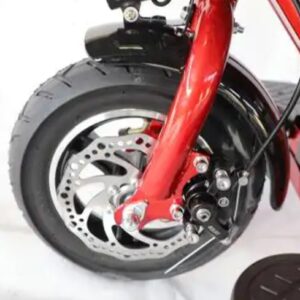
Brake diski
Àgwà:
- Nlekọta ọkụ kacha elu: breeki diski na-eme nke ọma n'ịgbasa okpomọkụ, na-eme ka ọ dị ngwa ngwa ma na-ebelata ihe egwu brek ga-ekpo oke ọkụ. Ọ bụ ezie na enwere ọnụ ahịa dị n'ihu, mmefu nlekọta oge ndụ ha nwere ike ịka njọ.
- Nzaghachi ngwa ngwa: Na-eme braking ozugbo na otu.
- Kachasị mma maka: Nyere njikwa okpomọkụ ha na nzaghachi ngwa ngwa, a na-akwado brek diski na ụgbọ ala chọrọ nkwụsị ngwa ngwa na ịrụ ọrụ elu.
Ihe ndọghachi azụ:
- Ha na-eji mkpado ọnụahịa mbido ka elu.
- Enwere ike idobekwu ya mgbe niile.
Ngwa na ndakọrịta ọkọlọtọ nke breeki
N'ahịa eletriki trike loader taa, breeki drum bụ nhọrọ kacha amasị n'ihi ihe ndị a:
Ọnụ ahịa arụmọrụ: Ịgba breeki na-etu ọnụ ahịa nrụpụta akụ na ụba karịa ma e jiri ya tụnyere sistemu breeki ọzọ. Uru ọnụ ahịa a na-amasị ma ndị na-emepụta ihe na ndị na-azụ ahịa na mpaghara eletriki trike loader ebe inweta uru kachasị maka ego bụ ihe kacha mkpa.
Ntụkwasị obi na Nkwalite Opekempe: Site n'ichepụta ha kwụ ọtọ na ogologo ogologo ogologo oge, breeki drum na-enye ndị ọrụ ohere ịchekwa ma nrụzi na ndochi, na-ahụ na igwe eletriki trike loader na-arụ ọrụ mgbe niile na ntụkwasị obi.
Ntughari: Ọdịdị nke breeki drum dabara nke ọma iji jikwaa breeki dị ịrịba ama, na-eme ka ha bụrụ nhọrọ maka ndị na-ebu ọkụ eletrik na-ebuli ibu dị arọ.
Enwere nhọrọ nhazi breeki dị iche iche, dịka ndị a:
Ịgba breeki atọ:
- Nchịkọta: Ụkwụ atọ ahụ nwere breeki drum.
- Uru: Ịgba breeki bụ omenala na-eguzogide mmiri na apịtị ma e jiri ya tụnyere diski diski, na-eme ka arụmọrụ na-agbanwe agbanwe na ọnọdụ dị iche iche. Ha na-adịkarị ọnụ ala ma na-achọ obere mmezi ka oge na-aga.
- Kwesịrị ekwesị maka: Ndị na-agba ọsọ na-ebute ụzọ breeki na-agbanwe agbanwe na mpaghara na ọnọdụ dị iche iche, na-enweghị mkpa maka nkwụsị ngwa ngwa na nnukwu ike.
Disc n'ihu nwere brek azụ Drum:
- Nchịkọta: wheel n'ihu na-eji breeki diski ebe azụ azụ na-eji breeki drum.
- Uru: Nchikota na-enye nzaghachi ngwa ngwa nke breeki diski n'ihu na arụmọrụ na-agbanwe agbanwe na nke a pụrụ ịdabere na ya nke breeki azụ. Ntọlite a na-edozi uru-ọnụ ahịa yana ike nkwụsi ike dị n'ihu.
- Kwesịrị ekwesị maka: Ndị na-achọ ntakịrị nzaghachi breeki n'ihu na-emebighị ntụkwasị obi nke breeki drum n'azụ.
Breeki diski atọ:
- Nchịkọta: Ụkwụ atọ niile nwere breeki diski.
- Uru: breeki diski na-enye ike nkwụsị dị elu yana ikpo ọkụ, ọkachasị n'oge ọnọdụ braking siri ike. Ha na-enye ahụmịhe breeki na-agbanwe agbanwe n'ofe ọnọdụ dị iche iche ma na-anabatakwa nke ọma.
- Kwesịrị ekwesị maka: Ndị na-anụ ọkụ n'obi na ndị na-agba ịnyịnya bụ ndị na-achọ ike kachasị n'ịrụ ọrụ breeki, karịsịa n'ọnọdụ ndị na-achọ nkwụsị ngwa ngwa ma ọ bụ n'oge mgbada ugwu.
Họrọ ALG Trike, nwere ike hụ na ọ bụghị naanị breeki dị mma ma kwụsie ike kamakwa nabata ịnya ụgbọ ala na mmefu ego dị iche iche.
Taya na Wheel Hub Ihe ndị dị mkpa
Nhọrọ taya maka ọgbara ọhụrụ eletrik
Mgbe ị na-ahọrọ igwe kwụ otu ebe ntụrụndụ, nkọwa taya taya bụ ihe dị mkpa a ga-echebara echiche, na-emetụta ma nkasi obi ịnya ụgbọ elu yana ọmarịcha mma nke igwe kwụ otu ebe ahụ. Na-emekarị, nha abụọ bụ isi na-achịkwa ahịa maka ịnya ụgbọ ala ntụrụndụ:
3.0-8 Nha:
- Kwesịrị ekwesị maka ndị na-achọ ọdụ ụkwụ kọmpat karịa, nha a na-enye ezigbo nkwụsi ike yana a na-ahụkarị ya na igwe igwe kwụ otu ebe emebere maka imegharị ya na oghere ndị siri ike.
3.0-10 Nha:
- Nhọrọ dị ntakịrị karịa, ọ na-enye ịnyagharị n'ụzọ dị nro n'elu ala dị iche iche, ọ bara uru karịsịa mgbe ị na-agafe obere ezughị okè nke okporo ụzọ ma ọ bụ okporo ụzọ na-adịghị mma.
Dị ka ihe atụ, ọ bụrụ na taya paramita bụ “3.0-10”, ebe “3.0” na-anọchi anya taya obosara, na “10” na-egosi dayameta dị n'ime taya taya. N'ozuzu, nnukwu nha dị oke ọnụ. Dịka ọmụmaatụ, taya 3.0-10 ga-adị ọnụ ahịa karịa taya 3.0-8.
Ihe Taya: Isi, enwere ụdị abụọ: taya radial na Agbamahụ taya.Taya radial n'ihi ike ha, na-egosipụta ịdịte aka dị elu, ọkachasị n'okpuru ibu dị arọ na ịnya ụgbọ ala dị anya. Ọ bụrụ na ịnya nkasi obi bụ mmasị, taya Bias ga-ezu.
Ngosipụta Taya Ply: Nkọwa ndị a na-ahụkarị gụnyere 4PR, 6PR, 8PR. Ngosipụta ndị a na-anọchi anya ikike ibu taya taya. Ka ọnụ ọgụgụ ply ahụ na-abawanye, otú ahụ ka ike ibu ibu ya ga-esiwanye ike.
Ụdị taya: Taya na-abịakarị n'ụdị abụọ: n'elu ewepụghị na mgbachi. Taya ndị dị larịị na-adị arọ ma na-eguzogide ọgwụ, dabara adaba maka ibu ibu buru ibu; ebe taya gbachiri agbachi na-enye ahụmịhe ịnya ụgbọ ala kwụsiri ike karị. Ya mere, ụfọdụ ndị nwere ụkwụ atọ nwere ike ịhọrọ taya agbagoro n'ihu yana taya dị larịị n'azụ.
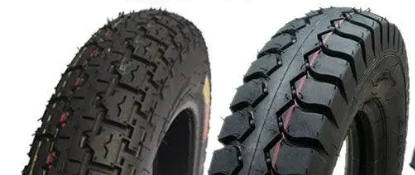
Ihe onwunwe Wheel Hub
Aluminom Alloy Wheel Hub: Aluminom alloy na-ewu ewu maka ịdị arọ ya, ike dị elu, yana ezigbo nguzogide corrosion. Ọ nwere ike inye ọkụ ọkụ ka mma, na-enyere aka belata oke ọkụ ọkụ, ma na-enye ụfọdụ nbelata ibu arọ maka ụgbọ ala.
Igwe igwe igwe: Steel bụ ihe dị arọ mana nke siri ike na ihe na-adịgide adịgide. Ụdị oghere wheel a na-efu obere ego, mana ịdị arọ ya nwere ike ịchụ obere ọrụ.
Taya bụ naanị ebe kọntaktị dị n'etiti igwe eletrik eletrik na ala, na-eme ka nhọrọ nke taya kwesịrị ekwesị dị oke mkpa. Maka okporo ụzọ dị larịị, anyị na-akwado ịhọrọ taya nwere obere nguzogide na-agbagharị agbagharị yana ihe mejupụtara dị nro, na-enye nkasi obi na ike dị mma. N'elu ala siri ike ma ọ bụ apịtị, a ga-ahọrọ taya ndị nwere ụkwụ miri emi iji hụ na ọ dị mma.
Nkwakọ ngwaahịa njem na AGL-Trike
Nkwakọ ngwaahịa ebufe ụgbọ ala
Na AGL-Trike, anyị na-anya isi na nlebara anya anyị na nkọwapụta na ntinye aka anyị na ịdị mma kachasị elu n'akụkụ niile, ruo na nkwakọ ngwaahịa anyị. Iji nye ndị ahịa anyị nghọta anya nke ọkachamara anyị, anyị na-egosipụta ọtụtụ usoro nkwakọ ngwaahịa zuru oke nke ụgbọ ala. Ụzọ anyị na-eme ka nchekwa na nchebe kachasị maka ngwaahịa ahụ, na-eme ka ọ rute gị n'ọnọdụ dị ọcha.
Nkwakọ ngwaahịa Sponge Basic
Nkwakọ osisi Frame
Nkwakọ ngwaahịa Frame Metal
- Frame metal nwere nkwakọ osisi osisi
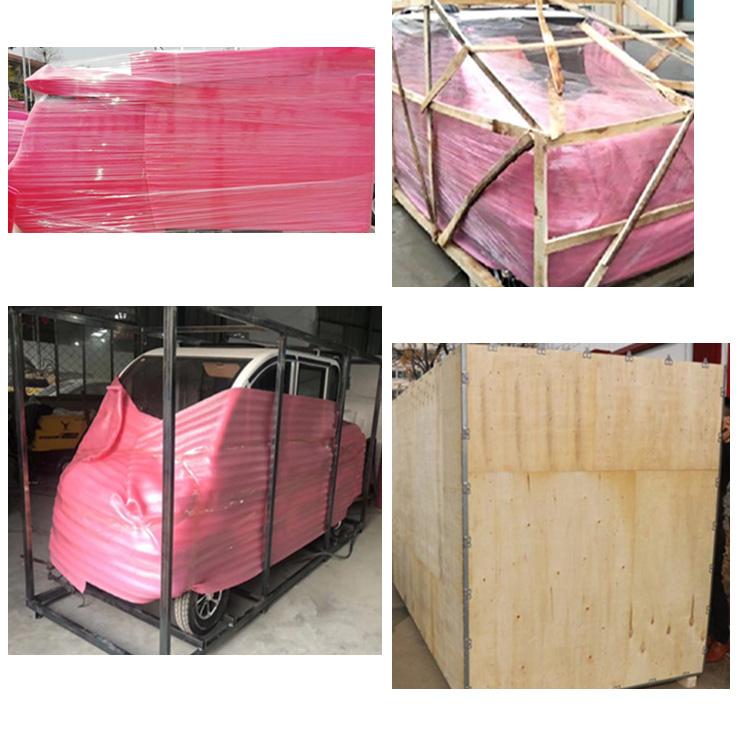
Nhọrọ nkwakọ ngwaahịa Omenala ọzọ
N'ịghọta na onye ahịa ọ bụla nwere ike ịnwe mkpa na mmasị dị iche iche ma a bịa n'ihe gbasara ibufe na mgbakọ, anyị na-enye nhọrọ nkwakọ ngwaahịa dị iche iche:
SKD (Akụkụla ọkara): Usoro nkwakọ ngwaahịa a gụnyere mkpokọta akụkụ. A na-achịkọta ihe ndị dị mkpa iche iche, na-enye nguzozi n'etiti ịdị mfe nke njem na mbelata mgbalị mgbakọ na ebe a na-aga.
CBU (Ewulitere kpamkpam): Ụgbọ ala a na-agbakọta nke ọma ma dị njikere maka ojiji ozugbo ọ bịarutere. Usoro a dị mma maka ndị ahịa na-ahọrọ ngwọta nkwụnye na-egwu na-enweghị mkpa maka mgbakọ mbupu.
CKD (Akụpịara ya kpamkpam): Nke a gụnyere ịgbasa ụgbọ ala ahụ kpamkpam. A na-akwakọba akụrụngwa nke ọ bụla n'otu n'otu n'otu n'otu, na-eme ka kọmpat na arụmọrụ n'oge njem. Usoro a zuru oke maka ebe ndị nwere ụkpụrụ mbubata kpọmkwem ma ọ bụ maka ndị ahịa nwere ikike mgbakọ pụrụ iche n'ime ụlọ.
Site n'inye nhọrọ nkwakọ ngwaahịa ndị a dị iche iche, anyị na-ahụ na ndị ahịa anyị nwere ike họrọ usoro dabara nke ọma na ngwa ngwa ha, ikike mgbakọ na mmasị ha. Ebumnuche anyị na AGL-Trike bụ ime akụkụ ọ bụla nke ịzụrụ ihe, gụnyere ụgbọ njem na nkwakọ ngwaahịa, dị ka enweghị nkebi na ahaziri dị ka o kwere mee.
Ajụjụ na n'ogbe na nhazi nke ugbo ala eletriki ntụrụndụ ntụrụndụ
Gịnị bụ MOQ nke Order?
Maka ọnụahịa mbupu kacha mma, anyị na-adụ ọdụ imeju akpa 20GP. Agbanyeghị, a na-anabata iwu anaghị ejuputa akpa site na ndetu ọnụ ahịa mbupu dị elu. Gwakọta ụdị tricycle dị iche iche 1-2 n'ime otu akpa maka ụdị dị iche iche yana ịrụ ọrụ ọnụ ahịa.
Gbaa mbọ hụ na ị nweta ihe kacha mma na mbupu, ọnụ ahịa na ụdị dị iche iche site na iji MOQ na nhọrọ mbupu anyị na-agbanwe agbanwe.
Gịnị bụ oge ndapụta a na-atụ anya ya?
Maka ụdị ọkọlọtọ, na-atụ anya oge ndu nke ụbọchị 15-25. Maka iwu omenala pụrụ iche, a na-eme atụmatụ oge nnyefe dabere na ihe ị chọrọ, na-eme ka ị mara mgbe ị ga-atụ anya iwu gị, ma nwee ike ịhazi ya.
Kedu oge akwụkwọ ikike maka igwe eletriki eletrik gị nwere oge ntụrụndụ gị?
Anyị na-enye akwụkwọ ikike afọ 1 maka ụgbọ ala anyị nwere ntụrụndụ, na-ekpuchi mmebi ọ bụla na-abụghị nke mmadụ mere. Jide n'aka na anyị kwụ n'azụ ịdị mma na ịdịte aka nke ngwaahịa anyị, na-enye gị nkwado ịzụrụ ihe a pụrụ ịdabere na ya.
Ị na-ebu ụgbọ mmiri na mba ofesi?
Ee, anyị na-eji ndị mmekọ ngwa ngwa tụkwasịrị obi na-ebu ụgbọ mmiri eletrik anyị.
A na-akwado igwe igwe eletriki eletrik gị ma kwekọọ n'ụkpụrụ mba ụwa?
Kpamkpam, anyị tricycles na-agbaso ụkpụrụ nchekwa na ịdị mma nke mba ụwa, na-ahụ na ntụkwasị obi na nchekwa maka ndị ahịa anyị niile.
Kedu ka ọrụ ire ere gachara?
Anyị na-enye ọrụ ọrịre ahịa zuru oke gụnyere inye akụrụngwa akụrụngwa, nkwado teknụzụ na enyemaka ndị ọzọ iji hụ na ị na-arụ ọrụ igwe eletriki eletrik nke ọma.
Kicksstart Ihe oru ngo gi Ugbu a!
Enwere oru n'uche ma ọ bụ ajụjụ ị ga-ajụ?
Echela! Ndị otu anyị dị njikere inye aka.
Anyị kpebisiri ike ịzaghachi n'ime awa 12.
- + 86 18367809612 (WhatsApp)
- info@agl-trike.com
Anyị ga-akpọtụrụ gị n'ime awa 12, biko ṅaa ntị na email na suffix "@agl-trike.com".



